Catalina 445
The California builder pumps up the performance in its new cruiser
The newly launched Catalina 445 is a design close to Gerry Douglas' heart. The Catalina designer and vice president describes the boat as having "fairly low freeboard and modest beam" with a hint of relish. It's a boat, he points out, that bucks the trend toward ultra-high-volume interiors. Instead it displays more traditional proportions. It's a boat, he said, that should appeal to a slightly younger, more performance-oriented sailor, one whose interests might include some racing as well as cruising. 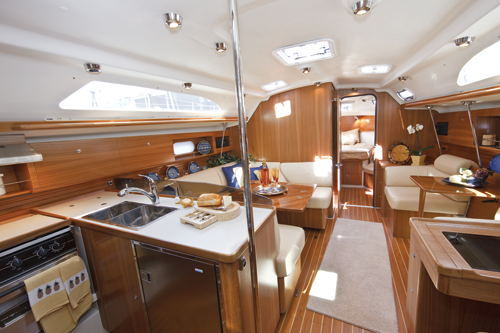
The 445 takes a place between the 42mkII and the 47, and alongside the CatalinaMorgan 440, which shares the 445's length, but is a deck saloon and quite different in look and layout. Douglas said the 445 is, "a little more performance oriented than the 42, and the exterior styling is a little more contemporary than the other boats."
Under sail the boat looks decidedly modern, but not space-age. The twin helms, large cockpit, considerable number of ports and hatches, and vertical battens on the in-mast furling mainsail all reveal its contemporary design. But the hull shape is hardly of-the-moment. In 30 years observant sailors will be able to identify the unmistakable Catalina lines, but will not be able to label the 445 as part of a design trend that came and went.
The details
The construction of the 445 follows the precedent set by other recent Catalina models. The hull is comprised of five major mold pieces and about 30 secondary pieces. The five major pieces are the hull, structural grid, hull liner, deck and deck liner. The hull is laid up with a mix of woven and knitted glass fabric. Douglas says the company uses vinylester resin in the outside laminate for blister protection and impact resistance, and polyester resin on the other laminates. It is solid below the waterline and balsa cored above. The combination of structural grid and hull liner provide all of the necessary rigidity, so that the furniture is not integral to the build of the hull. This allows for considerable latitude when it comes to interior layout. In the case of the 445 it translates into a remarkably airy saloon that does not seem as though it could fit aboard a boat with "fairly low freeboard and modest beam." The deck is balsa cored except at all the key hardware fittings, where it is solid glass. The deck liner provides additional structural rigidity. 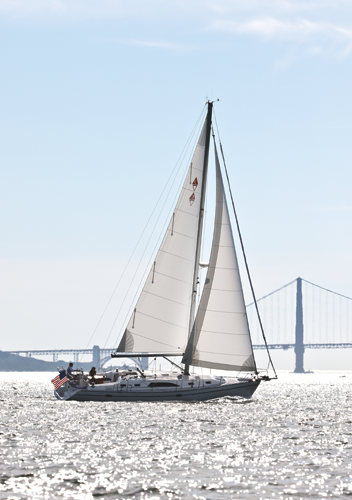
During the course of construction, the transom is attached while the hull is still in the mold. Once the hull is removed from the mold it is placed in a female analog to the mold, which provides support for the entire hull throughout the process of construction. This cradle has several cutouts to allow access for installing through-hull fittings. The majority of the interior build is completed before the deck is attached. At the end of the process, when all the components have been assembled and the boat has its full structural rigidity, it is removed from the cradle and the keel is attached.
On deck
On deck, beginning at the bow, an optional sprit attaches to pre-installed fittings allowing for an asymmetrical spinnaker or code zero. The mast is a 15/16ths fractional rig with a masthead spinnaker halyard, which Douglas says allows enough room for a sock to fit above the forestay and keep it out of the way of the upper end of the jib's roller furling. The anchor windlass fits beneath the shaped chain locker cover at the aft end of a remarkably spacious chain well. "I made the forefoot deep and round to keep volume," Douglas said. In addition to adding buoyancy to a fine bow, this creates plenty of storage room for a heavy-duty, all-chain ground tackle system.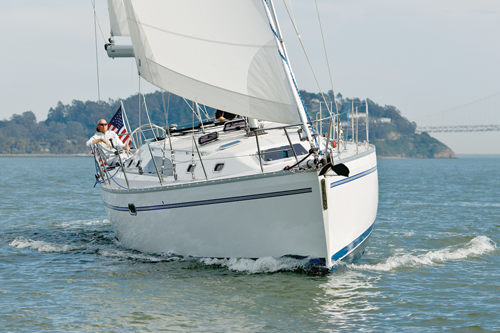
The deck is printed with two different diamond-shaped nonskid patterns. There is a rougher, superior traction pattern on the high-traffic areas of the deck, and a finer pattern on areas like the top of the cockpit coaming. The lifelines are wire, the current standard, which eliminates the hazard of hidden corrosion posed by vinyl-coated lines. Douglas says that the 3/16 1x19 wire is meathook free.
The mast is deck-stepped and stands 63 feet, 10 inches above the waterline. It is supported by a beefy strut that runs down through the forward head to rest on a stainless steel transverse I-beam that is incorporated into the structural grid. Douglas says that 70 percent of buyers will opt for the standard in-mast furling system, while about a quarter of them will upgrade to an in-boom system. Only a handful will choose to go with a traditional main. The standing rigging is wire and the chain plates are part of a ball-and-socket tie rod system of Douglas' design, which seems like a smart way of transferring the load to a pair of aluminum I-beams that run for some 10 feet along the inner wall of the hull as a complement to the structural grid.
The halyards, mainsheet and traveler all run through rope clutches to the aft end of the cabintop on either side of the companionway, where there are a pair of secondary winches. The primary winches are well aft, and within easy reach of the helmsman when seated at the leeward wheel. All four winches can be upgraded to electric power with easy access to the underside from the cabins.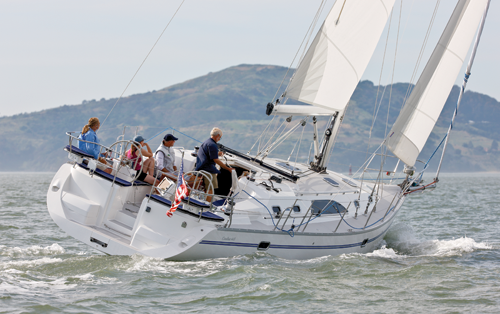
The beam is carried well aft and the cockpit benefits from this with plenty of space. Douglas says he designed the benches to be long enough to sleep on during hot nights at anchor. The paired helmsman's seats wrap well around outboard, offering plenty of seating options while at the wheel. Both wheels have instrument readouts, while the engine control is at the starboard wheel. The fixed folding cockpit table has a swiveling mount on the aft end for the chartplotter and radar screen, which can be read from either helm position.
The split backstay makes for easy cockpit access across the swim platform. The transom has two built-in lockers (in addition to large twin lazarettes under the helmsman's seats), one for propane and the other large enough to accommodate a couple of six gallon dinghy fuel tanks. The pushpit has a built-in bracket for mounting the dinghy outboard motor.
Down below
Down below there is a convertible two- or three-cabin layout. The owner's cabin is forward with its own head, including a built-in shower stall with a spinnaker cloth curtain, which Douglas says is quick drying and naturally mold resistant. The toilets in both heads are electric-macerating and have their own tanks that are gravity draining and placed above the toilet and outboard. The bunk in the owner's cabin tilts up to about 45 degrees at the head end using a rocker switch. 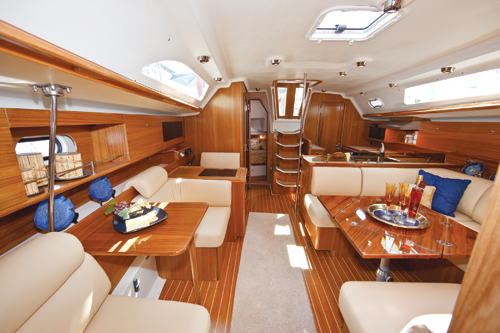
The furniture is teak veneer over plywood at midpanel, but all the corners and edges are solid teak to allow for damage repair when nicked or dinged. The finish is also clear, without any stain, to allow for seamless repairs. The cabin sole is made of composite plastic, but the surface mimics teak and holly right down to the grain, and is essentially indistinguishable from the real thing unless you are on your hands and knees. It has the added advantages of being light and durable.
The guest cabin is aft on the starboard side and offers access to the second head through one of its two doors. Access to that head can also be made through a door aft of the nav station at the base of the companionway ladder. The third cabin is a convertible space that can serve as a multi-berth cabin, a sail storage locker (accessible from the cockpit) or a workbench area. 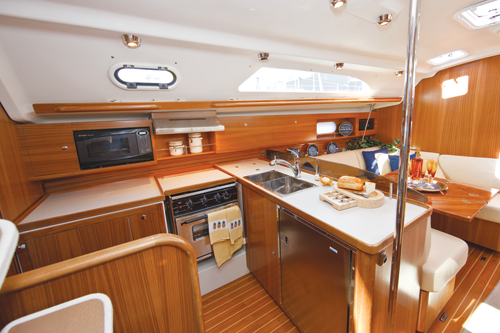
The saloon includes a galley to port and nav station to starboard. The L-shaped galley has both a front-opening refrigerator and a top-opening unit that can serve as either a fridge or a freezer. The A/C inverter is located under the galley sink where it creates heat that draws air out of the bilge through a perforated plate, reducing moisture. The bilge is tidy and well organized throughout, and in the galley allows enough space under the cabin sole to store several cases of wine, according to Douglas. Across on the starboard side, the forward-facing navigator's station is clean and simple. In a recessed well on the table there is space for a laptop computer with power outlets and cable routings all inside the table. The idea is that all instrument readings that are available on deck can be routed through the laptop for the navigator. Outboard, above the seat, is the breaker panel with built-in amp meter and space for mounting additional gauges or an SSB.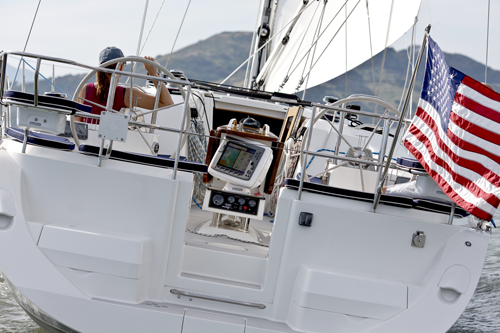
The saloon itself is notably roomy and has a U-shaped settee with a folding dining table to port, forward of the galley, and a pair of seats with their own smaller table to starboard, forward of the nav station.
Under sail
The conditions during our test sail felt more like Annapolis than San Francisco, with 3 to 12 knots of wind and milky, lifeless skies. Although we didn't get to test the boat in heavy-air conditions, as we often do here, there was enough wind to get a feel for the way the 445 handles. Away from the dock we managed nearly 8 knots at cruising speed with the Yanmar 54-horsepower engine. Hoisting sail is a simple matter of unfurling the main and the standard 135-percent jib. It takes just a few seconds. The boom is high, allowing plenty of cockpit clearance, but the mast is tall, making for a good-sized main. 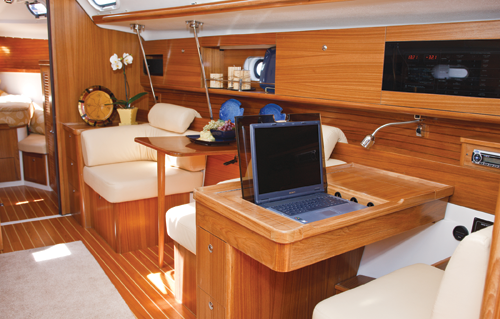
The feeling at the wheel is firm, and the twin helms with the cushioned wraparound seats made it remarkably easy to find a comfortable driving position with good line of sight. I can't think of another boat where I have felt quite so comfortable sitting at the helm. Sitting to leeward and outboard in light breeze, it was easy to reach the primary winch and trim the headsail without any awkward stretching. While reaching, we hoisted a Code Zero borrowed from a Catalina 42, and although we didn't get every square foot of sail area that we would have from a sail built for the 445, it was a chance to test the bow sprit. Like everything else on a Gerry Douglas-designed boat, it is well considered and easy to use.

Comments